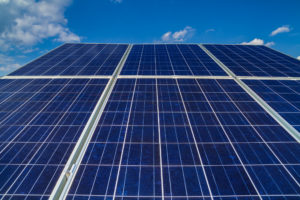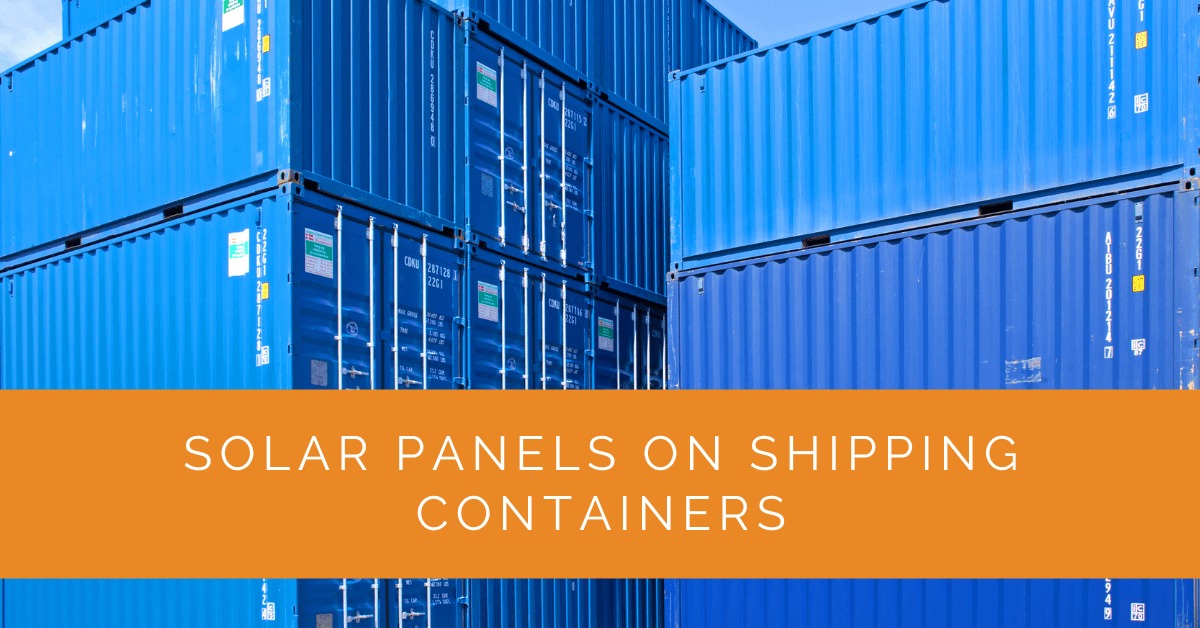Solar panels have revolutionized the energy industry, providing sustainable and cost-effective power solutions in various applications. One of the most innovative uses of solar panels is their installation on shipping containers, offering a portable and versatile platform for generating solar power. This article will explore the benefits, customization options, installation techniques, and real-life applications of solar panels on shipping containers.
Contents
- 1 Key Takeaways
- 2 Why Solar Panels on Shipping Containers?
- 3 Customization and Modular Configurations
- 4 Solar Panel Kits for Shipping Containers
- 5 Mounting and Clamping Systems
- 6 Maximizing Power Generation
- 7 Real-Life Applications
- 8 Case Study: Solar Panel Installation on Shipping Containers
- 9 Expert Insights From Our Solar Panel Installers About Solar Panels on Shipping Containers
- 10 Experience Solar Excellence with Us!
- 11 Conclusion
- 12 FAQ
Key Takeaways
- Solar panels on shipping containers offer a versatile and cost-effective solution for harnessing renewable energy, providing sustainable power in various applications.
- Customization and modular configurations allow for tailored solar panel installations to fit shipping container dimensions, while solar panel kits simplify installation.
- Proper mounting and clamping systems and optimization techniques like tracking systems and battery storage integration maximize power generation from container solar installations.
Why Solar Panels on Shipping Containers?
Advantages of Using Shipping Containers as a Solar Panel Platform
Shipping containers are known for their robust structure, making them an ideal foundation for solar panel installations. They offer several advantages for harnessing solar power:
- Cost-Effectiveness: Repurposing shipping containers reduces material costs for constructing additional structures, making solar installations more affordable.
- Versatility: Shipping containers are mobile and can be easily transported to different locations, enabling solar power generation in remote areas or during temporary events.
- Reduced Environmental Impact: By utilizing existing shipping containers, we reduce the need for new construction materials, minimizing our carbon footprint and promoting sustainability.
Customization and Modular Configurations
When it comes to solar panels on shipping containers, customization is key. These containers come in various sizes and configurations, allowing for tailored solar panel installations.
Tailoring Solar Panel Installations to Fit Shipping Container Dimensions
Solar panel systems can be designed to fit the dimensions of shipping containers perfectly. This ensures optimal utilization of the available space and maximizes the power generation capacity.
Customization Options for Various Shipping Container Sizes and Configurations
Solar panel installations can be customized to meet your specific needs, whether working with a standard 20-foot container or a larger 40-foot container. Customization options include:
- Roof Installations: Mounting solar panels on the roof of the shipping container provides a compact and efficient solution, utilizing the available space effectively.
- Side Installations: In cases where the roof space is limited or needs to be preserved for other purposes, solar panels can be mounted on the sides of the shipping container. This configuration allows for greater flexibility and modular expansion.
Modular Approaches for Scalability and Flexibility in Solar Panel Deployment
Modularity is a key advantage of shipping container solar installations. Solar panels can be installed modularly, allowing for easy expansion or reconfiguration as power demands increase or location requirements change. This scalability ensures that solar power systems adapt to evolving needs and circumstances.

Solar Panel Kits for Shipping Containers
Solar panel kits specifically designed for shipping containers are available in the market for seamless and hassle-free installations. These kits include all the necessary components for a complete solar power system.
Components Included in a Shipping Container Solar Panel Kit
Typically, a shipping container solar panel kit consists of the following components:
- Solar Panels: High-quality photovoltaic panels capable of converting sunlight into electrical energy.
- Mounting and Racking System: Secure structures to mount the solar panels on the container’s roof or sides.
- Inverter: Converts the direct current (DC) the solar panels produce into alternating current (AC) for use in electrical systems.
- Charge Controller: Regulates the flow of electricity from the solar panels to the battery bank, preventing overcharging and optimizing battery performance.
- Battery Storage: Stores excess energy generated by the solar panels for later use, ensuring a continuous power supply even during cloudy days or at night.
- Wiring and Electrical Components: A safe and efficient solar panel installation requires cables, connectors, and electrical components.
Benefits of Using Solar Panels Kits for Easy Installation and Setup
Solar panel kits designed for shipping containers offer several benefits:
- Simplified Installation: Kits come with detailed instructions, making the installation process straightforward and accessible to professionals and DIY enthusiasts.
- Compatibility: Components within the kit are designed to work together seamlessly, ensuring optimal performance and compatibility.
- Time and Cost Savings: Solar panel kits eliminate the need for extensive research and sourcing of individual components, saving time and reducing overall costs.
- Reliability: Kits are often backed by warranties, providing peace of mind and support in case of any technical issues.
Mounting and Clamping Systems
Proper mounting and clamping systems are essential to ensure the stability and longevity of solar panel installations on shipping containers.
Securely Mounting Solar Panels on Shipping Container Roofs or Sides
Mounting solar panels on shipping container roofs or sides requires robust and secure attachment mechanisms. Here are some common methods:
- Bolted Connections: Utilizing pre-drilled holes in the container’s roof or sides, solar panel mounting brackets can be securely bolted to ensure a stable and durable installation.
- Clamping Systems: Adjustable clamps designed for shipping container solar installations offer flexibility in mounting solar panels on the container’s roof or sides without compromising the container’s structural integrity.
Ensuring Stability and Durability in Challenging Weather Conditions
Shipping container solar installations must withstand various weather conditions. Proper mounting and clamping systems and durable materials help ensure stability and longevity even in harsh environments. Factors to consider include wind loads, corrosion resistance, and the use of appropriate sealants to prevent water ingress.

Maximizing Power Generation
Several factors should be considered to optimize solar power generation from shipping container installations.
Optimizing Solar Panel Angles and Orientations for Maximum Sunlight Exposure
Adjusting the tilt angle and orientation of solar panels helps maximize sunlight exposure, enhancing energy production. Factors such as latitude, seasonal variations, and site-specific conditions play a role in determining the optimal angles for solar panels.
Tracking Systems to Enhance Energy Production Efficiency
Solar panel tracking systems can increase energy production by dynamically adjusting the panel’s position to face the sun throughout the day. While fixed installations are more common due to their simplicity, tracking systems are beneficial when maximum energy generation is desired.
Integrating Battery Storage Systems for Reliable Power Supply
Battery storage systems play a crucial role in shipping container solar installations. They store excess energy generated during sunny periods and provide power during cloudy days or at night, ensuring a continuous and reliable power supply.
Real-Life Applications
Shipping container solar installations have found practical applications in various industries and scenarios.
Off-Grid Power Solutions for Remote Locations and Disaster-Stricken Areas
Shipping containers with solar panels offer self-sustaining power solutions for remote locations, off-grid communities, and disaster-stricken areas. These installations provide immediate access to electricity, enabling vital services such as lighting, medical facilities, and communication devices.
Mobile Power Stations and Portable Energy Solutions
The mobility of shipping containers and solar power presents opportunities for portable energy solutions. Mobile power stations can be created by equipping containers with solar panels, batteries, and inverters. These stations can be deployed for temporary events, construction sites, or emergency power needs.
Case Study: Solar Panel Installation on Shipping Containers
Background
At Solar Panels Network USA, we have always been committed to innovative and sustainable solar solutions. One of our recent projects involved installing solar panels on shipping containers to provide a mobile and versatile power source for a remote research facility. This case study highlights our approach, the challenges we faced, and the successful implementation of this unique solar power solution.
Project Overview
The project aimed to deliver a reliable and sustainable power source to a remote research facility located in an area with limited access to traditional energy infrastructure. The use of shipping containers as the foundation for the solar panels provided a practical solution, offering mobility, durability, and ease of installation.
Implementation
Assessment and Planning
Our first step was to assess the site and determine the energy requirements of the research facility. We conducted a thorough analysis to ensure that the solar panel system would meet the facility’s power needs. Given the remote location, we also factored in the potential for future expansion and scalability.
Customization and Design
We opted for a modular approach, using multiple 20-foot shipping containers to house the solar panels. This configuration allowed us to tailor the installation to the specific dimensions of the containers, maximizing the available space for solar panels. We designed the system to include roof and side installations, optimizing sunlight exposure throughout the day.
Installation Process
The installation involved several key steps:
Reinforcing the Containers
We began by reinforcing the shipping containers to support the additional weight of the solar panels. This included strengthening the roof structures and ensuring the containers were securely anchored.
Mounting the Solar Panels
Using a combination of bolted connections and adjustable clamping systems, we mounted the solar panels on the roofs and sides of the containers. This method provided stability and durability, crucial for the challenging weather conditions expected in the remote location.
Electrical Integration
We installed high-quality inverters and battery storage systems to ensure efficient energy conversion and storage. The batteries provided a reliable power supply during periods of low sunlight, ensuring continuous operation for the research facility.
Testing and Optimization
After the installation, we conducted rigorous testing to verify the system’s performance. We adjusted the tilt angles of the solar panels to maximize sunlight capture and integrated a tracking system to further enhance energy production.
Results
The solar panel installation on shipping containers proved highly successful, delivering reliable and sustainable power to the remote research facility. Key outcomes included:
Energy Independence
The facility achieved energy independence, significantly reducing its reliance on traditional power sources. The solar panels generated sufficient electricity to meet the facility’s daily operational needs, with excess energy stored in the batteries for use during nighttime or cloudy days.
Cost Savings
By repurposing shipping containers and utilizing solar energy, the project realized substantial cost savings. The reduced material and transportation costs, combined with the long-term savings on energy expenses, demonstrated the financial viability of this innovative solution.
Environmental Impact
The project contributed to a significant reduction in carbon emissions and environmental impact. By harnessing renewable energy and repurposing existing containers, we minimized the need for new construction materials and promoted sustainability.
Summary
Our project demonstrated the effectiveness and versatility of using shipping containers as a platform for solar panel installations. This approach provided a cost-effective, scalable, and environmentally friendly solution for the remote research facility. By embracing innovative techniques and prioritizing sustainability, we successfully delivered a reliable power source that met the facility’s energy needs and set a precedent for future solar projects.
Expert Insights From Our Solar Panel Installers About Solar Panels on Shipping Containers
Shipping containers offer a robust and versatile platform for solar panels, making them ideal for mobile and remote power solutions. Their durability ensures that the solar panels remain secure and efficient in various conditions.
Senior Solar Installer
One of the significant advantages of installing solar panels on shipping containers is the ability to customize and expand the system as needed. This flexibility is crucial for meeting specific energy demands and adapting to changing environments.
Lead Solar Technician
Using shipping containers for solar installations reduces material costs and promotes sustainability by repurposing existing structures. It’s a win-win for both cost-efficiency and environmental impact.
Solar Installation Expert
Experience Solar Excellence with Us!
Trust in Solar Panels Network USA, where our seasoned experts deliver top-quality solar solutions for homes and businesses nationwide. With a legacy of countless successful installations and a commitment to sustainable energy, we’re your reliable partner in the solar journey. Ready for a brighter, eco-friendly future? Call us now at (855) 427-0058 and harness the power of the sun!
Conclusion
Solar panels on shipping containers provide an innovative and sustainable approach to power generation. Their versatility, cost-effectiveness, and customizable nature make them a compelling choice for various applications. Whether off-grid power solutions, mobile energy stations, or simply reducing environmental impact, solar panels on shipping containers offer a greener and more flexible future. Embrace this technology and unlock the potential of renewable energy for versatile and portable power solutions.
Always consult with professionals and adhere to local regulations when planning and installing solar panel systems on shipping containers.
FAQ
Can you put solar panels on a shipping container?
Yes, solar panels can be installed on shipping containers. The robust structure of shipping containers makes them suitable platforms for solar panel installations, offering a versatile and portable solution for generating renewable energy.
How many solar panels can you put on a 20-foot container?
The number of solar panels that can fit in a 20-foot shipping container depends on various factors, such as the size of the solar panels and the desired configuration. It is recommended to consult with solar panel professionals or suppliers to determine the optimal number of panels based on the specific dimensions and requirements of the container.
About the Author
Solar Panels Network USA stands at the forefront of solar energy solutions, driven by a team of seasoned solar engineers and energy consultants. With over decades of experience in delivering high-quality solar installations and maintenance, we are committed to promoting sustainable energy through customer-centric, tailored solutions. Our articles reflect this commitment, crafted collaboratively by experts to provide accurate, up-to-date insights into solar technology, ensuring our readers are well-informed and empowered in their solar energy decisions.

